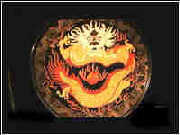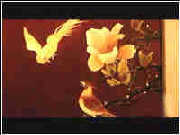 An ancient art form, when blended with modern techniques, can take on a brand-new and dazzling look; this is especially true with the art of mosaic lacquer painting, which formed in China (the birthplace of lacquer art) in 1995. Having its root in traditional Chinese culture and imbued with a strong sense of modern art, the art represents a perfect combination of traditional culture and modern high technology, and is hailed as one of the three treasures of traditional art of ancient China, together with Chineseceramicsand silk.
An ancient art form, when blended with modern techniques, can take on a brand-new and dazzling look; this is especially true with the art of mosaic lacquer painting, which formed in China (the birthplace of lacquer art) in 1995. Having its root in traditional Chinese culture and imbued with a strong sense of modern art, the art represents a perfect combination of traditional culture and modern high technology, and is hailed as one of the three treasures of traditional art of ancient China, together with Chineseceramicsand silk.
As early as in the Neolithic age about 7,000 years ago, the ancestors of Chinese people, when cutting down trees, found that the juice of the lacquer trees could be painted on walls and furniture, thus giving birth to primitive lacquer art. With a unique ability to resist corrosion, thelacquerwarehas survived various weather conditions, and has become known as a "living fossil" of traditional Chinese art, as well a special witness of traditional Chinese culture.
 Both the industrial and artistic value of lacquerware reflected the cultural characters of various times. For example, the lacquerware ofHemuduCulture, which dates back 4,000 years ago, was simple and clumsy, while that of theBronzeAge was bright and colorful; lacquer art reached its peak in theMing Dynasty(1368-1644), while in theQing Dynasty(1644-1911), much importance was attached to details.
Both the industrial and artistic value of lacquerware reflected the cultural characters of various times. For example, the lacquerware ofHemuduCulture, which dates back 4,000 years ago, was simple and clumsy, while that of theBronzeAge was bright and colorful; lacquer art reached its peak in theMing Dynasty(1368-1644), while in theQing Dynasty(1644-1911), much importance was attached to details.
The art of Chinese mosaic lacquer painting, forged on the basis of the lacquer-art traditions of more than 1,000 years, has the most special artistic language, and is unique in terms of artistic charm.
As a form of lacquer art, mosaic lacquer paintings exist in a wide cultural range. They can be found inpeople's dailylife as well as in Buddhist and Taoisttemples; seen in common residences or department stores; given as birthday gifts or used as funeral articles or chariot decorations. The paintings, with different patterns and high artistic standards, vividly depict the social life of every stratum, reflecting artists' excellent skills and the unique charm of Chinese traditional and modern art.
